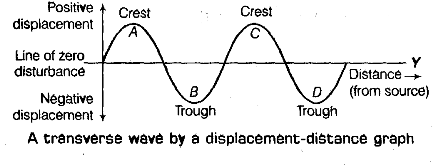Longitudinal and Transverse Waves







Longitudinal and Transverse Waves
Types of waves: Mainly there are two types of waves.
Longitudinal Waves: The individual particles of the medium move in a direction parallel to the direction of propagation of the disturbance. The particles do not move from one place to another but they simply oscillate back and forth about their positions of rest. This is exactly how a sound wave propagates, hence sound waves are longitudinal waves. Longitudinal waves can be produced in all the three media such as solids, liquids and gases.
Graphical Representation of a Longitudinal Wave: When a longitudinal wave passes through air, the density of air changes continuously.

Transverse Waves: In transverse waves, the individual particles of the medium move about its mean position in a direction perpendicular to the direction of wave propagation. e.g. Light is a.transverse wave (but it is not a mechanical wave). Transverse waves can be produced only in solids and liquids but not in gases. Examples:
1. The waves produced by moving one end of a long spring or rope, up and down rapidly, whose other end is fixed, are transverse waves.
2. The water waves (or ripples) formed on the surface of water in a pond (when a stone is dropped in the pond of water) are transverse waves. A transverse wave travels horizontally in a medium, the particles of the medium vibrate up and down in the vertical direction. In transverse waves, crest and trough are formed. A crest is that part of the transverse wave which is above the line of zero disturbance of the medium. A trough is that part of the transverse wave which is below the line of zero disturbance of the medium.
Graphical Representation of a Transverse Wave: A transverse wave has been represented by a displacement-distance graph as shown below.

Longitudinal waves can be produced in ______________________. | |||
| Right Option : D | |||
| View Explanation | |||
Transverse waves can be produced only in_________________. | |||
| Right Option : D | |||
| View Explanation | |||
Sound travels in rocks in the form of ________________________ | |||
| Right Option : C | |||
| View Explanation | |||
Students / Parents Reviews [10]
My experience was very good with Abhyas academy. I am studying here from 6th class and I am satisfied by its results in my life. I improved a lot here ahead of school syllabus.

Ayan Ghosh
8thOne of the best institutes to develope a child interest in studies.Provides SST and English knowledge also unlike other institutes. Teachers are co operative and friendly online tests andPPT develope practical knowledge also.

Aman Kumar Shrivastava
10thAbhyas Methodology is very good. It is based on according to student and each child manages accordingly to its properly. Methodology has improved the abilities of students to shine them in future.

Manish Kumar
10thMy experience with Abhyas academy is very good. I did not think that my every subject coming here will be so strong. The main thing is that the online tests had made me learn here more things.

Hiya Gupta
8thIt was good as the experience because as we had come here we had been improved in a such envirnment created here.Extra is taught which is beneficial for future.

Eshan Arora
8thBeing a parent, I saw my daughter improvement in her studies by seeing a good result in all day to day compititive exam TMO, NSO, IEO etc and as well as studies. I have got a fruitful result from my daughter.

Prisha Gupta
8thAbout Abhyas metholodology the teachers are very nice and hardworking toward students.The Centre Head Mrs Anu Sethi is also a brilliant teacher.Abhyas has taught me how to overcome problems and has always taken my doubts and suppoeted me.

Shreya Shrivastava
8thA marvelous experience with Abhyas. I am glad to share that my ward has achieved more than enough at the Ambala ABHYAS centre. Years have passed on and more and more he has gained. May the centre flourish and develop day by day by the grace of God.

Archit Segal
7thI have spent a wonderful time in Abhyas academy. It has made my reasoning more apt, English more stronger and Maths an interesting subject for me. It has given me a habbit of self studying

Yatharthi Sharma
10thIt was a good experience with Abhyas Academy. I even faced problems in starting but slowly and steadily overcomed. Especially reasoning classes helped me a lot.
